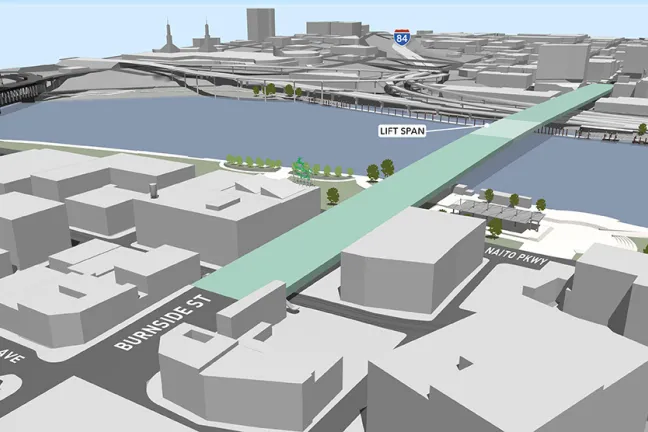On November 14 Multnomah County’s Board of Commissioners will vote on two issues to advance the county’s Earthquake Ready Burnside Bridge project. One vote will confirm the range of alternatives and evaluation criteria for a study that will lead to a preferred alternative recommendation in 2020. The second will decide how local funds will be raised to help pay for the project. The agenda items are part of the Board meeting next Thursday starting at 9:30 a.m. in the first floor boardroom at 501 SE Hawthorne Blvd. The meeting includes time for public comment.
The project’s purpose is to create a seismically resilient Burnside Street lifeline crossing of the Willamette River that will remain fully operational and accessible after a major Cascadia Zone earthquake. Geologists say there is a one in three chance such an earthquake will strike our region in the next 50 years. If the earthquake occurred today, none of the downtown bridges are expected to be usable for weeks or months.
The three build alternatives recommended for study are:
- An enhanced seismic retrofit that upgrades the existing bridge
- A replacement movable bridge on the same alignment as the existing bridge
- A replacement movable bridge that extends NE Couch Street west toward the river, eliminating the sharp curve on the current westbound approach
Cross sections for two bridge widths, with different layouts for traffic, are recommended to study. The seismic retrofit alternative maintains the existing bridge width and layout, while the replacement options add 20 feet of width over the river. The extra width creates room for wider bike lanes, crash barriers between bicycle and traffic lanes, and slightly wider traffic lanes.
Two options for managing traffic during construction are recommended for study: detouring all traffic to other bridges and constructing a temporary detour bridge to carry traffic during four to six years of construction.
The Board will also be asked to approve evaluation criteria for 13 topics, ranging from cost to impacts to natural resources and businesses. The alternatives will be scored for how they perform for various measures related to these criteria.
The project’s Community Task Force and Policy Group of elected and appointed officials recommended the proposed package of alternatives and evaluation criteria at meetings this fall.
In a separate vote, the Board will consider a proposed increase in Multnomah County’s local vehicle registration fee (VRF) to fund the county’s share of the project. The current fee of $19 per year per vehicle would be raised $37 a year to a total of $56 per year, starting in January 2021. Multnomah County currently has the lowest local VRF of the three Metro area counties.
In addition to revenue from the local vehicle fee, the county is seeking regional, state and federal funds for the project, which will be its largest capital project to date. The estimated cost is between $550 and $850 million, depending on the alternative selected and whether a detour bridge is built.
Increasing the VRF requires two votes by the Board. The second vote is scheduled December 5, 2019. Public comments will be accepted before and at the Board meetings. Information on the proposed fee increase and an online comment form are available at: /vrf.
After the Board votes on the alternatives and evaluation criteria, Multnomah County will file a Notice of Intent to the Federal Highway Administration to formally begin the project’s environmental phase. That phase will identify the preferred alternative. Design and construction will follow.
For more information, visit www.burnsidebridge.org. Multnomah County maintains the Burnside Bridge and leads the Earthquake Ready Burnside Bridge project.

